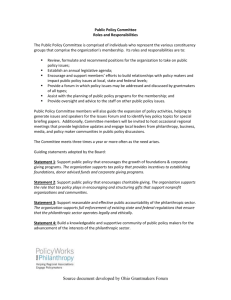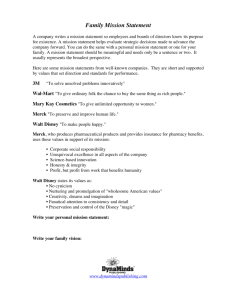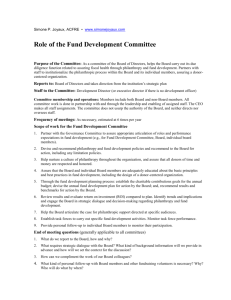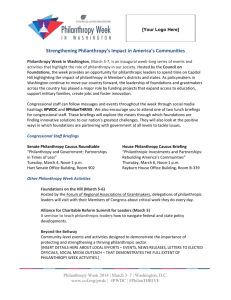Market-Based Solutions for Financing Philanthropy
advertisement
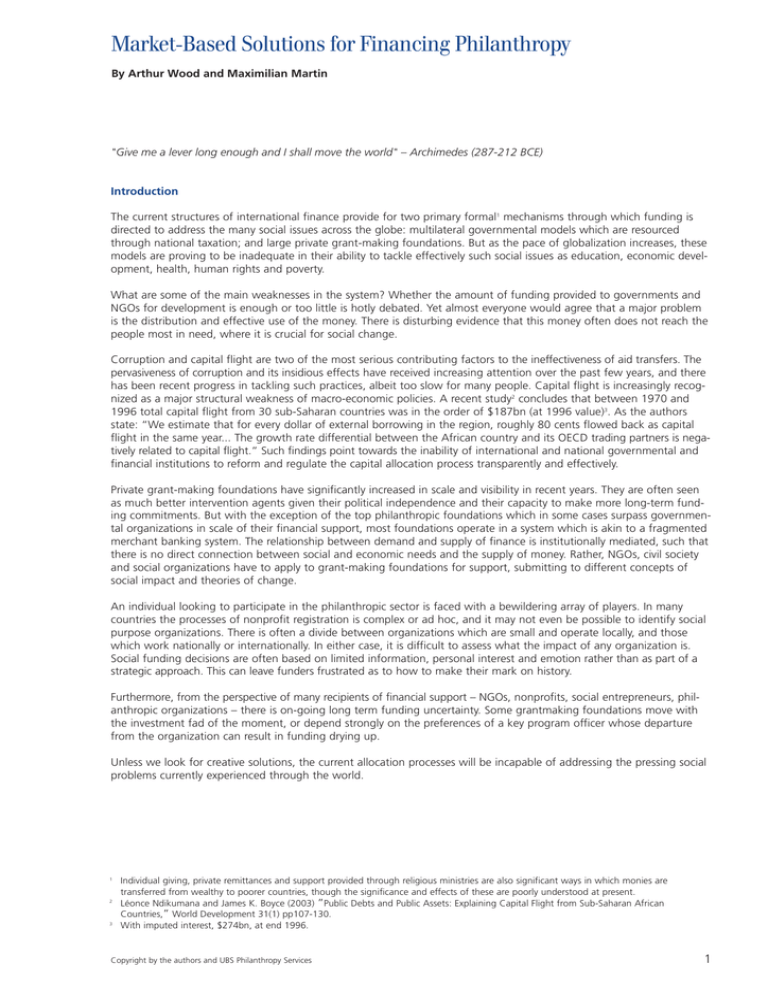
Market-Based Solutions for Financing Philanthropy By Arthur Wood and Maximilian Martin "Give me a lever long enough and I shall move the world" – Archimedes (287-212 BCE) Introduction The current structures of international finance provide for two primary formal1 mechanisms through which funding is directed to address the many social issues across the globe: multilateral governmental models which are resourced through national taxation; and large private grant-making foundations. But as the pace of globalization increases, these models are proving to be inadequate in their ability to tackle effectively such social issues as education, economic development, health, human rights and poverty. What are some of the main weaknesses in the system? Whether the amount of funding provided to governments and NGOs for development is enough or too little is hotly debated. Yet almost everyone would agree that a major problem is the distribution and effective use of the money. There is disturbing evidence that this money often does not reach the people most in need, where it is crucial for social change. Corruption and capital flight are two of the most serious contributing factors to the ineffectiveness of aid transfers. The pervasiveness of corruption and its insidious effects have received increasing attention over the past few years, and there has been recent progress in tackling such practices, albeit too slow for many people. Capital flight is increasingly recognized as a major structural weakness of macro-economic policies. A recent study2 concludes that between 1970 and 1996 total capital flight from 30 sub-Saharan countries was in the order of $187bn (at 1996 value)3. As the authors state: “We estimate that for every dollar of external borrowing in the region, roughly 80 cents flowed back as capital flight in the same year... The growth rate differential between the African country and its OECD trading partners is negatively related to capital flight.” Such findings point towards the inability of international and national governmental and financial institutions to reform and regulate the capital allocation process transparently and effectively. Private grant-making foundations have significantly increased in scale and visibility in recent years. They are often seen as much better intervention agents given their political independence and their capacity to make more long-term funding commitments. But with the exception of the top philanthropic foundations which in some cases surpass governmental organizations in scale of their financial support, most foundations operate in a system which is akin to a fragmented merchant banking system. The relationship between demand and supply of finance is institutionally mediated, such that there is no direct connection between social and economic needs and the supply of money. Rather, NGOs, civil society and social organizations have to apply to grant-making foundations for support, submitting to different concepts of social impact and theories of change. An individual looking to participate in the philanthropic sector is faced with a bewildering array of players. In many countries the processes of nonprofit registration is complex or ad hoc, and it may not even be possible to identify social purpose organizations. There is often a divide between organizations which are small and operate locally, and those which work nationally or internationally. In either case, it is difficult to assess what the impact of any organization is. Social funding decisions are often based on limited information, personal interest and emotion rather than as part of a strategic approach. This can leave funders frustrated as to how to make their mark on history. Furthermore, from the perspective of many recipients of financial support – NGOs, nonprofits, social entrepreneurs, philanthropic organizations – there is on-going long term funding uncertainty. Some grantmaking foundations move with the investment fad of the moment, or depend strongly on the preferences of a key program officer whose departure from the organization can result in funding drying up. Unless we look for creative solutions, the current allocation processes will be incapable of addressing the pressing social problems currently experienced through the world. 1 2 3 Individual giving, private remittances and support provided through religious ministries are also significant ways in which monies are transferred from wealthy to poorer countries, though the significance and effects of these are poorly understood at present. Léonce Ndikumana and James K. Boyce (2003) ”Public Debts and Public Assets: Explaining Capital Flight from Sub-Saharan African Countries,” World Development 31(1) pp107-130. With imputed interest, $274bn, at end 1996. Copyright by the authors and UBS Philanthropy Services 1 A Market with Missing Links Could the mechanisms of the financial market provide solutions to such weaknesses? Looking at the social sector through the capital market lens is helpful: from this perspective the social sector looks like a capital market with a missing link – banks. Missing are banking systems which provide platforms to channel and direct capital flows. The capital market for social finance is substantial: in the US alone this market creates an annual turnover of $1 trillion – and even then there is a considerable annual shortfall. Many organizations with the potential to grow are unable to do so because they cannot tap into an easy-to-access capital market. And almost all nonprofits have to spend too much of their time trying to raise money rather than pursuing their core missions. There are not enough organizations able to systemically expand and strengthen their work in order to really resolve social issues. Recent research in the US and UK has highlighted the problematic nature of current fundraising practices and relationships9. The cost of such bilateral fundraising is viewed by many as too high and can be as high as 50%. Let alone the short term nature of most funding and the complexity of having to manage multiple funding sources with different terms, different reporting schedules and different monitoring requirements. The commercial banking sector performs the function of raising capital in the private sector, providing a more cost effective and more coherent institutional arrangement. The Emergence of New Allocation Opportunities There are clear signs of a shift in the allocation of social capital finance – new allocation processes driven mainly by market mechanisms to efficiently target capital to tackling the most pressing and serious social issues. This can be seen practically in a number of ways. • The global growth of social purpose organizations in the last ten years has not only led to some of the above mentioned problems, but has also resulted in many cases in innovative and cost efficient delivery of social services to the developing world and underprivileged sectors of society at much lower unit cost. • The growth of social entrepreneurship and similar movements has unleashed the power of creative and ethical entrepreneurship on the social sector, advancing social change with the same entrepreneurial drivers one would see in the private business sector. • The rise of microfinance solutions, the growth of venture philanthropy and concepts such as triple bottom line investing or sustainability indices have started to introduce new financing mechanisms for social development. These developments and innovations can be linked to a growing interest in social investment from potential investors. In the US alone it is estimated that the largest transfer of wealth in human history, of the order of $41 trillion, will take place in the next fifty years resulting in a huge social investment potential, connected with the ability to manage capital risk at increasingly smaller capital amounts. There have been changes spurred on by globalization: market models for the social sector have gained much more credibility, globalization has generated new opportunities, driven by the growth of technology, specifically mobile technology. The result is a confluence of social and economic factors encouraging this growth of the market system in philanthropy. Such factors could encourage banks to enter this huge but inefficient capital market and to perform their core function – the intermediation of capital to the benefit of both their clients and the social capital market. A Changing View For this development to accelerate, funders and social investors have to move away from the somewhat schizophrenic view that they sometimes hold: as donors, they are often happy to make grants, which provide an allocation that has a minus 100% return, or zero financial return; while as investors, they prioritize how to make financially profitable investments. Copyright by the authors and UBS Philanthropy Services 2 This is counter-intuitive in investment terms. In terms of market efficiency, clearly the range of "best practice” in social and economic terms would be between these two points. There are certainly some social investments which may never provide a direct positive return in economic terms, though they may contribute to economic progress overall, such as democratic development and the upholding of human rights. But, paradoxically, utilizing skills already available in the capital markets, mechanisms could be created that provide a positive economic return for an investment where the underlying investment loses money. In the past few years, both institutional and retail investment clients have been educated in a range of financial products with differing economic returns, sometimes even with guaranteed returns. In the institutional space CDOs (Collateralized Debt Obligations) and hedge funds have seen phenomenal growth. In the private client sphere this development has been mirrored in structured and guaranteed products. There is no practical reason why some of these ideas cannot be applied to social and economic return. Conclusion: Creating the Mechanisms for Market-Based Solutions It is clear that there is an inefficient capital market for social finance, at the levels of the state, the nonprofit sector and the private sector. Traditional banks are not involved, and the potential efficiencies that the private sector could offer are not currently brought into play in any significant way. At times it seems as if the philanthropic sector relates to the big picture, but primarily operates in a small scale when compared to other sectors of the global economy. Given the need for market-based solutions, Ashoka has decided to work with others in developing the key elements of a solution. Such a solution must mobilize the substantive knowledge of banks in the field of commercial finance, creating processes that allow the aggregation of capital and the deployment of capital on a scale that will change the nature of social financing. In particular, this requires: • Creating mechanisms that bring full transparency to the market • Creating transparency by drawing together players that can aggregate demand on clear platforms – where the risk can be defined to the best available abilities • Engaging the corporate sector in tandem with the citizen sector, nonprofit organizations, and civil society organizations • Ensuring effective implementation of the processes to address social issues • Defining clear benchmarks of success to allow further injections of capital Although in their infancy, many of these models and mechanisms are already in existence, either in the private sector or in the philanthropic sector. They need to be brought to scale. This requires cooperation between governmental, commercial and philanthropic sectors, by targeting capital to the people most in need. This will in turn empower people and communities who are currently marginalized. It is time to unleash the power of the market and private capital on the most pressing social issues of our time. Copyright by the authors and UBS Philanthropy Services 3

